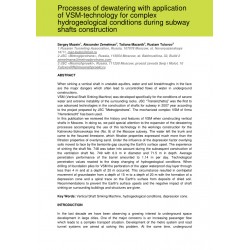Cart
0
0
No document
0,00 €
Total
Document successfully added to your shopping cart
Quantity
Total
There are 0 items in your cart.
There is 1 item in your cart.
Total documents
Total shipping
To be determined
Total
Search & filter
Search for a publication
Search & filter
Processes of dewatering with application of VSM-technology for complex hydrogeological conditions during subway shafts construction
2486_processes_of_dewatering_wit
S. Mazein / A. Zemelman / T. Mazanik / R. Tulovov
When sinking a vertical shaft in unstable aquifers, water and soil breakthroughs in the face are the major dangers which often lead to uncontrolled flows of water in underground constructions. VSM (Vertical Shaft Sinking Machine) was developed specifically for the conditions of severe water and extreme instability of the surrounding rocks. JSC “Transinzhstroj” was the first to use advanced technologies in the construction of shafts for subway in 2007 year according to the project prepared by JSC ”Metrogiprotrans”. The mechanized complex VSM of firma ”Herrenknecht” has been used. In this publication we reviewed the history and features of VSM when constructing vertical shafts in Moscow. In doing so, we paid special attention to the expansion of the dewatering processes accompanying the use of this technology in the workings construction for the Kalininsko-Solncevskaja line (No. 8) of the Moscow subway. The water left the trunk and came to the fissured limestone, which filtration properties expressed much more than the filtration properties of overlying sand. Under the influence of the depression factor overlying soils moved to face by the bentonite gap causing the Earth's surface upset. The experience of sinking the shaft No. 748 was taken into account during the subsequent construction of the ventilation shaft No. 749 with 6.3 m in diameter and 71.5 m in depth. Average penetration performance of the barrel amounted to 1.14 m per day. Technological penetration values reacted to the sharp changing of hydrogeological conditions. When drilling of foundation piles for VSM the perforation of the upper waterproof clay layer through less than 4 m and at a depth of 20 m occurred. This circumstance resulted in centripetal movement of groundwater from a depth of 15 m to a depth of 20 m with the formation of a depression cone and a spiral trace on the Earth's surface from deposits of dried soil. Recommendations to prevent the Earth's surface upsets and the negative impact of shaft sinking on surrounding buildings and structures are given. Vertical Shaft Sinking Machine, hydrogeological conditions, depression cone.




